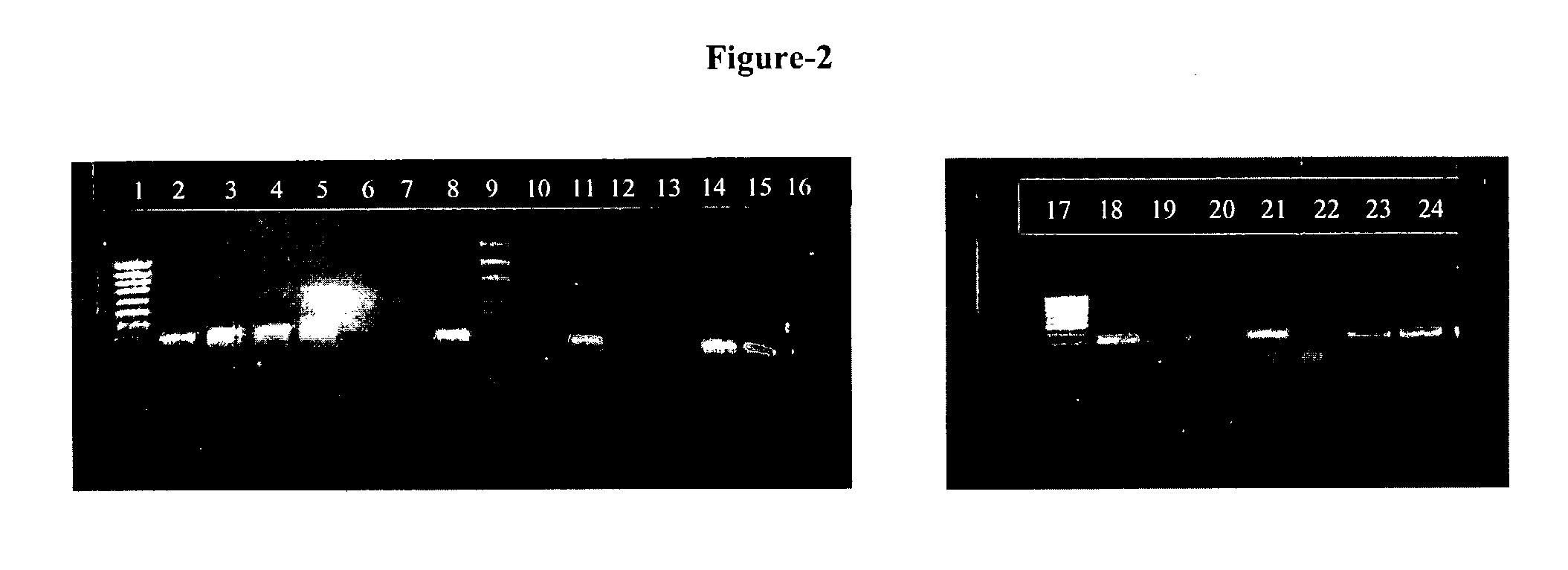Methods for detection of mycobacterium tuberculosis
a technology of mycobacterium tuberculosis and detection methods, which is applied in the field of methods for detection of mycobacterium tuberculosis, can solve the problems of the inability to find the indian laboratory, and the inability to use conventional methods
- Summary
- Abstract
- Description
- Claims
- Application Information
AI Technical Summary
Benefits of technology
Problems solved by technology
Method used
Image
Examples
example 1
Clinical Samples:
[0053] Clinical samples were obtained from patients attending the out patient department (OPD), or hospitalized patients at the All India Institute of Medical Sciences (AIIMS), New Delhi, India. All the samples were processed in the Clinical Microbiology Division, Department of Laboratory Medicine. A total of 3072 patients who attended the general OPD of AIIMS, with complaints of fever, cough and expectoration were investigated to rule out tuberculosis, as a routine work-up. However, only 265 of these patients had clinico-radiological findings suggestive of tubercular etiology and were referred to specialized clinics. These referred patients fulfilled the inclusion criteria as per CDC guidelines and were included in this study. After informed consent of the patients, their routine investigations were carried out and their blood samples were also tested for human Immunodeficiency virus (HIV) infection. The clinical samples investigated for Mycobacterial isolation i...
example 2
Microscopy and Routine Culture:
[0054] The slide smears were air dried and heat fixed. One set of smears was stained with auramine-O (A-O) fluorochrome staining and examined under epifluorescence at 400× using Nikon®™ fluorescent microscope and the another set stained with Zeihl-Neelsen staining and examined under oil emersion (1000×). The results and quantification of acid fast bacilli (AFB) were reported as per revised WHO guidelines (33): scanty (1 or 2 AFB in 300 oil fields), 1+(3-9 AFB in 100 fields), 2+(1-10 AFB per oil field), or 3+(10 or more AFB per oil field).
[0055] Culture and identifications were made according to the standard method (12, 36) by inoculating on a Lowenstein-Jensen (L-J) slant with 0.2 to 0.5 ml of the decontaminated sputum sample. Cultures were incubated at 37° C. till the growth or for 8 weeks whatsoever was early. The cultured Mycobacteria were identified by staining and standard biochemical methods including Niacin, heat stable catalase, aryl sulphat...
example 3
Extraction of Genomic DNA:
[0056] The DNA was isolated directly from the Mycobacterium cultures by a procedure which the applicants have been following in the laboratory for the last several years. Briefly: 2-3 loopful (˜100 mg) of Mycobacterial cultures was transferred to an eppendorf tube containing 200 μl of sterile distilled water. The suspension was incubated at 80° C. in a water bath for 20 minutes. To the suspension 200 μl chloroform was added followed by vortexing. The suspension was again incubated at 65° C. for 10 minutes and centrifuged at 9000 rpm for 2 minutes. The clear supernatant containing Mycobacterial DNA was taken for assay.
PUM
| Property | Measurement | Unit |
|---|---|---|
| Length | aaaaa | aaaaa |
| Stability | aaaaa | aaaaa |
Abstract
Description
Claims
Application Information
 Login to View More
Login to View More - R&D
- Intellectual Property
- Life Sciences
- Materials
- Tech Scout
- Unparalleled Data Quality
- Higher Quality Content
- 60% Fewer Hallucinations
Browse by: Latest US Patents, China's latest patents, Technical Efficacy Thesaurus, Application Domain, Technology Topic, Popular Technical Reports.
© 2025 PatSnap. All rights reserved.Legal|Privacy policy|Modern Slavery Act Transparency Statement|Sitemap|About US| Contact US: help@patsnap.com



